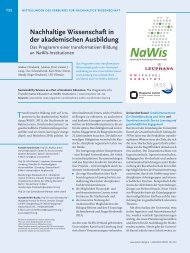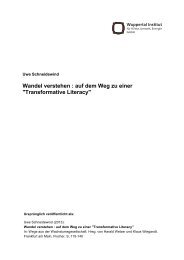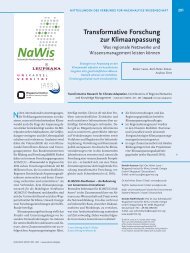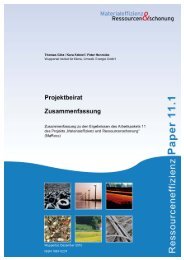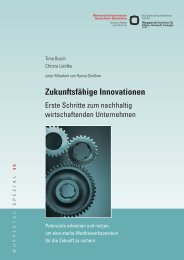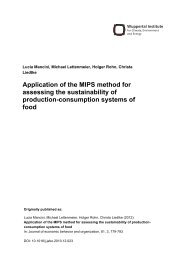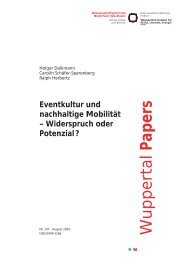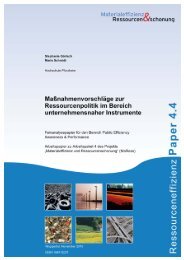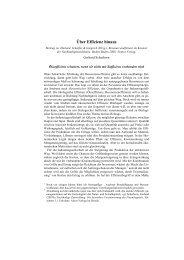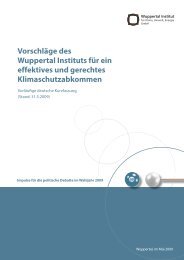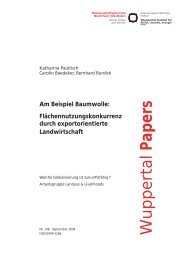Resource Efficiency Atlas - Publication Server of the Wuppertal ...
Resource Efficiency Atlas - Publication Server of the Wuppertal ...
Resource Efficiency Atlas - Publication Server of the Wuppertal ...
You also want an ePaper? Increase the reach of your titles
YUMPU automatically turns print PDFs into web optimized ePapers that Google loves.
30<br />
25<br />
20<br />
15<br />
10<br />
5<br />
0<br />
Global Oil Consumption (in bn. t)<br />
today 2050<br />
Figure 2: Worldwide demand for raw materials in 2050 without increasing efficiency levels<br />
(Source: Hennicke 2006)<br />
on oil consumption, number <strong>of</strong> cars, and global resource<br />
extraction in 2050.<br />
The relevance <strong>of</strong> different business sectors in terms <strong>of</strong><br />
resource consumption varies from country to country. The<br />
most resource intensive sectors in Germany, for instance,<br />
are construction, food and beverage, metal and semi-fin-<br />
ished metal goods, as well as <strong>the</strong> energy and motor vehi-<br />
cle sectors (Acosta-Fernández 2007). In Finland, however,<br />
mining and construction are <strong>the</strong> most intensive sectors,<br />
followed by agricultural, forestry and wood-processing in-<br />
dustry sectors. The car industry only plays a minor role here<br />
(Mäenpää 2005). This demonstrates that for each country<br />
different technologies, products and, thus, different strate-<br />
gies are relevant in order to improve resource efficiency.<br />
An analysis <strong>of</strong> resource consumption by areas <strong>of</strong> de-<br />
mand (see figure 3) reveals that in industrialised societies<br />
<strong>the</strong> majority <strong>of</strong> resources are used for housing and nutrition.<br />
This refers to resources directly contained by consumer<br />
goods as well as to lifecycle-wide (indirect) resource<br />
consumption such as energy used for manufacturing or<br />
distribution. Fur<strong>the</strong>rmore, mobility plays a central role here<br />
when analysed separately (e.g. driving to <strong>the</strong> supermarket<br />
within <strong>the</strong> field <strong>of</strong> nutrition) and not integrated within<br />
each demand area (Mat<strong>the</strong>ws et al. 2000; Bringezu / Schütz<br />
2001; Kotakorpi / Lähteenoja / Lettenmeier 2008).<br />
In general, higher resource efficiency not only within <strong>the</strong><br />
above mentioned fields <strong>of</strong>fers various benefits for society<br />
and economy (e.g. Ritth<strong>of</strong>f et al. 2007; Bringezu 2004; Van<br />
der Voet et al. 2005; Schmidt-Bleek 2007; Liedtke / Busch<br />
2005). Examples are:<br />
Cost reduction (production and product costs as well<br />
as <strong>the</strong> reduction <strong>of</strong> costs during <strong>the</strong> use-phase),<br />
5<br />
4<br />
3<br />
2<br />
1<br />
0<br />
Worldwide Car Fleet (in bn.)<br />
today 2050<br />
300<br />
250<br />
200<br />
150<br />
100<br />
50<br />
0<br />
Global <strong>Resource</strong> Extraction (in bn. t)<br />
today 2050<br />
Securing raw material supply,<br />
Decreasing environmental impacts during <strong>the</strong> entire<br />
lifecycle.<br />
Fur<strong>the</strong>rmore, resource efficiency facilitates product and<br />
production innovation and opens up new markets for<br />
products with reduced resource input. Here, national<br />
markets as well as international export markets can be addressed.<br />
A study by Roland Berger Consultants points out<br />
that environmental technologies show high market potential<br />
and a dynamic growth around <strong>the</strong> globe (Bundesministerium<br />
für Umwelt 2007). The six leading markets identified<br />
in this study (environmentally friendly energy production<br />
and storage, energy efficiency, material efficiency, recycling,<br />
sustainable mobility, and sustainable water management)<br />
already represented a total volume <strong>of</strong> about one<br />
trillion euros in 2005. Considering <strong>the</strong> average growth rate<br />
<strong>of</strong> each <strong>of</strong> <strong>the</strong>se markets, <strong>the</strong> market for raw material and<br />
material efficiency is expected to have <strong>the</strong> highest annual<br />
Food and Drinks<br />
(incl. alcoholic drinks)<br />
Apartment,Water, Electricity, Gas<br />
and o<strong>the</strong>r fuels<br />
Traffic<br />
Furniture, Appliances, Gadgets and<br />
Equipment for <strong>the</strong> Household incl. Maintenance<br />
Lodging and Restaurant Services<br />
26 %<br />
19 %<br />
19 %<br />
16 %<br />
9 %<br />
4.473.912<br />
7.696.969<br />
Figure 3: <strong>Resource</strong> consumption incl. ecological backpack <strong>of</strong> especially<br />
resource intensive areas <strong>of</strong> demand in Germany for <strong>the</strong> year<br />
2000, in percent and 1,000 tons (Source: Acosta-Fernández, 2011)<br />
12.644.777<br />
9.223.308<br />
9.140.765<br />
Ressourceneffizienzatlas<br />
<strong>Resource</strong> <strong>Efficiency</strong> <strong>Atlas</strong> 7



